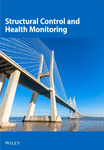Experimental verification and numerical studies of an autonomous semi-active seismic control strategy
Abstract
An autonomous semi-active control strategy is proposed for seismic control of structures. The control strategy is designed so that the resulting non-linear damping force can control the response of the structure, for both intermediate and high excitation levels. A series of experiments are performed to verify the performance of a variable oil damper controlled by the proposed control law. The inertia force driven loading (IFDL) system is employed for the verification test. The time histories and hysteresis curves of the damping force and base shear are presented for harmonic loading, showing that the damper successfully generates the damping force commanded by the algorithm. The hysteresis loops produced by the semi-active force provide energy absorption capacity similar to those of friction dampers while reducing the disadvantages of friction dampers, namely the residual displacements and the transfer of the high frequency content of the control forces. Numerical analysis of a six-degree-of-freedom model of a base isolated structure is presented as an example. The proposed control method is shown to be effective for reduction of seismic response of the structure in both intermediate and high seismic excitation levels. Copyright © 2005 John Wiley & Sons, Ltd.




